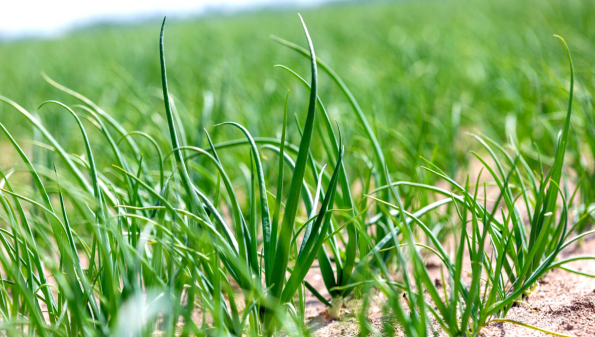a miracle of nature
The onion has a complex physiology. From germination to the ripening of the onion bulb, numerous climatic and agronomic factors influence the development of the onion plant. After the emergence of the first real onion leaf, this development roughly takes place in three phases: the vegetative phase (creation of the onion leaves), the bulbing phase (with the lushest possible green foliage) and the ripening phase (drying out of the onion leaves and the final ripening of the bulb). In this edition we limit ourselves to the vegetative phase.
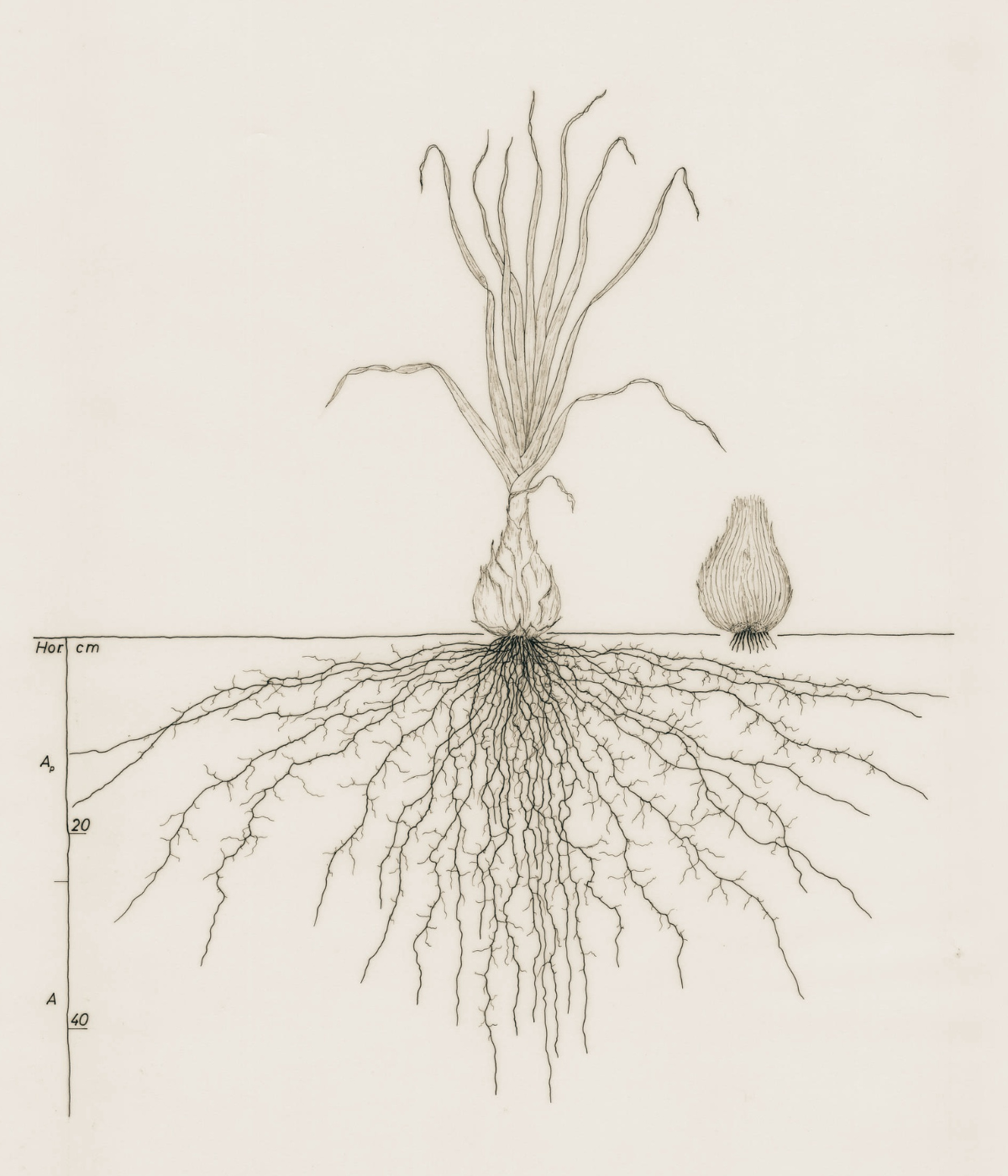
Unique rooting
When germinating, the onion forms one primary root, the radicle. The primary root's job is to anchor the onion seed in the ground. Simultaneously with the formation of the first true onion leaf, the radicle dies off and is replaced by new roots. These roots have little to no root hairs and do not branch. A Holland Onion also forms all its roots in shallow ground between 0 and 60 cm. Tests have even shown that 90% of the root system roots to a depth of only 18 cm. Unlike other crops, this typical rooting pattern of the Dutch onion hardly changes. This meager, low root density makes it difficult to exploit the soil efficiently. Nevertheless, the onion crop can withstand periods of drought very well, because the stomata in the onion leaves quickly close with a small degree of moisture deficiency. Also an onion leaf has a thick wax layer that reflects sunlight and prevents evaporation. However, this does mean that growth will stop if there is a persistent lack of moisture. Attention to continuous, good moisture management is essential and a recurring element in the daily ritual of the Dutch onion grower. Because a healthy growing onion crop is also more resistant to diseases and plagues.
Foliage is indicator
The number of leaves an onion plant eventually forms is determined by temperature, development speed and plant density. At a higher temperature, an onion will form leaves more quickly, while no more leaves will form once the plant initiates bulbing. At an average 24-hour temperature of 15 °C, a new leaf will appear every 8 days. (source: Onion Cultivation Manual 53 DLV). The leaf development must be maintained at a good level during the growth phase, both qualitatively and quantitatively. It is an important indicator for a future, good development of the onion bulb. After all, the leaves react to light and temperature and are responsible for photosynthesis.
Flamboyant personality
The onion plant is a flamboyant personality in every phase of its growth. The onion is the only vegetable that stubbornly appears with the center of the seedling above the earth line an arch; the arch stage. After a day or three the slightly withered tip also emerges from underground flying like a flag on the frail sprout: the flag leaf stage. Roots and the first real leaf start forming and the flag leaf dies off. And then it goes fast.
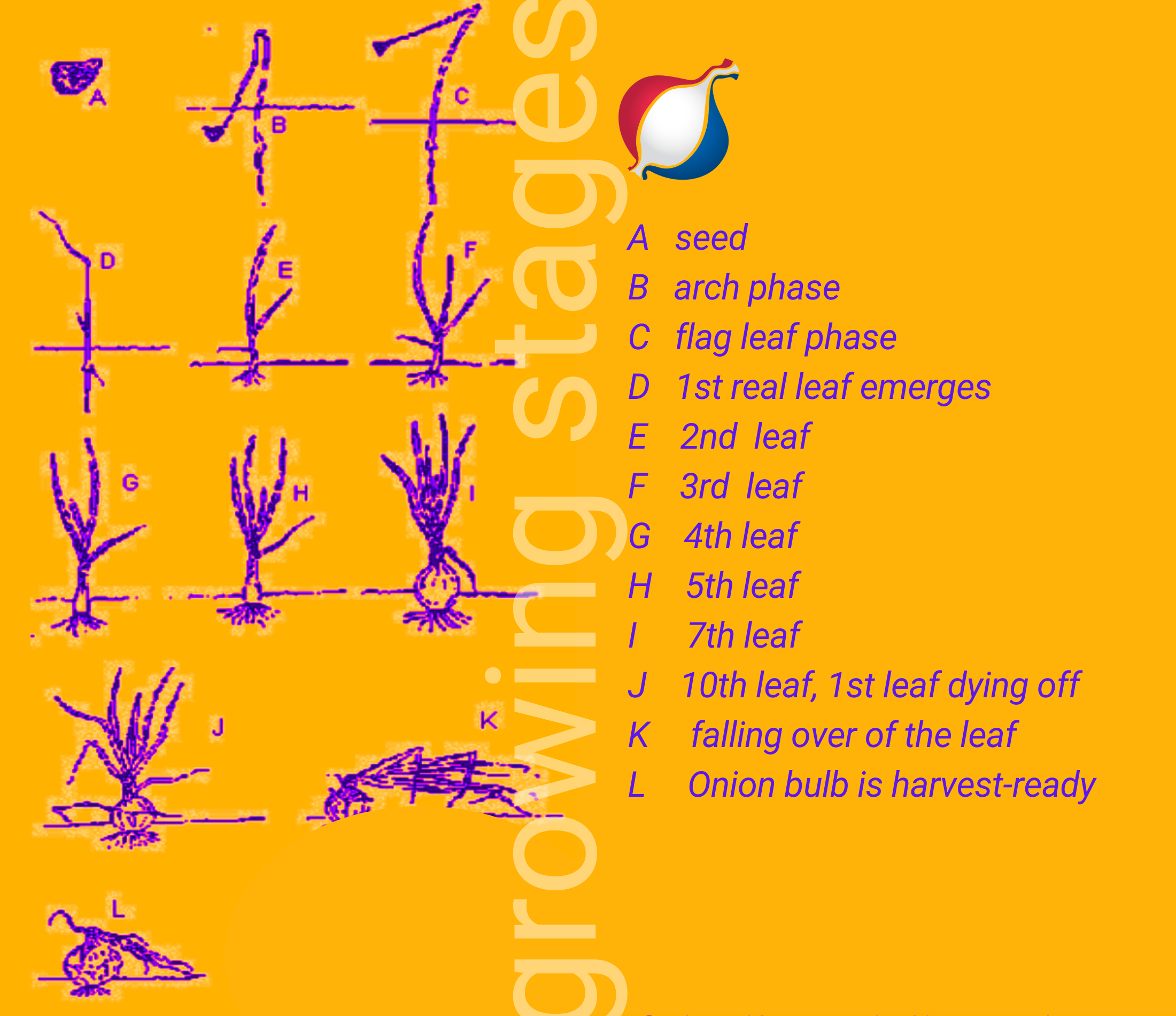
At 20 degrees Celsius, a new leaf will appear every five days. Although the onion foliage looks like leaves in the field, they are actually elongated, hollow tubes. They are ring-shaped and closed at the top. It looks as if the tops don't grow directly from the bulb base, but from a stem which is therefore called ‘pseudo stem’. The onion's true stem is just a thin, cork-like disc on the bottom of the bulb to which the roots are attached. The outermost layers dry out during the growth process and form an important defence against invaders from outside.
Carrying a wax coat
All onion tubes have a protective epidermis as cover tissue. The epidermis of the stem and leaf have a water-repellent wax layer containing stomata, which are tiny openings in the epidermis with two guard cells. In light, the stomata open and carbon dioxide is taken up for the process of photosynthesis. Glucose is formed in the chlorophyll as a nutrient and oxygen as a by-product. Water and oxygen is evaporated through the stomata. In addition to being a building block, water is also an important means of transport for nutrients in the plant and also ensures that the plant can cool down by evaporating moist. At night, the process is reversed and the plant absorbs oxygen from the air and emits carbon dioxide as waste, just as we humans continuously do, whether it is night or day.
High crop temperature
A good continuous water supply of the onion crop is a precondition for a qualitatively and quantitatively optimal yield. Moist is also essential for the effective use of nutrients by the onion plant and prevents unnecessary loss of nutrients. The crop temperature during the day can rise considerably with onions. This can be as much as 4 to 8 degrees (and leaf temperatures sometimes as much as 10 degrees) higher than the air temperature at the official measuring altitude. The temperature in summer between an upright open crop such as the Holland Onion is therefore often higher than a crop that grows widely. After 5 warm, successive sunny days, a field of onions quickly evaporates 15 mm of moisture. Moisture that evaporates must be supplemented in via sprinkling or irrigation, if the plant is to continue growing healthily. An experienced onion grower regularly feels his soil and starts irrigating as soon as clumps no longer form after compacting the soil. This then decomposes into virtually loose granules. With two mm of irrigation per day, the onion crop is able to absorb just as much water in a dry period to maintain crop growth.
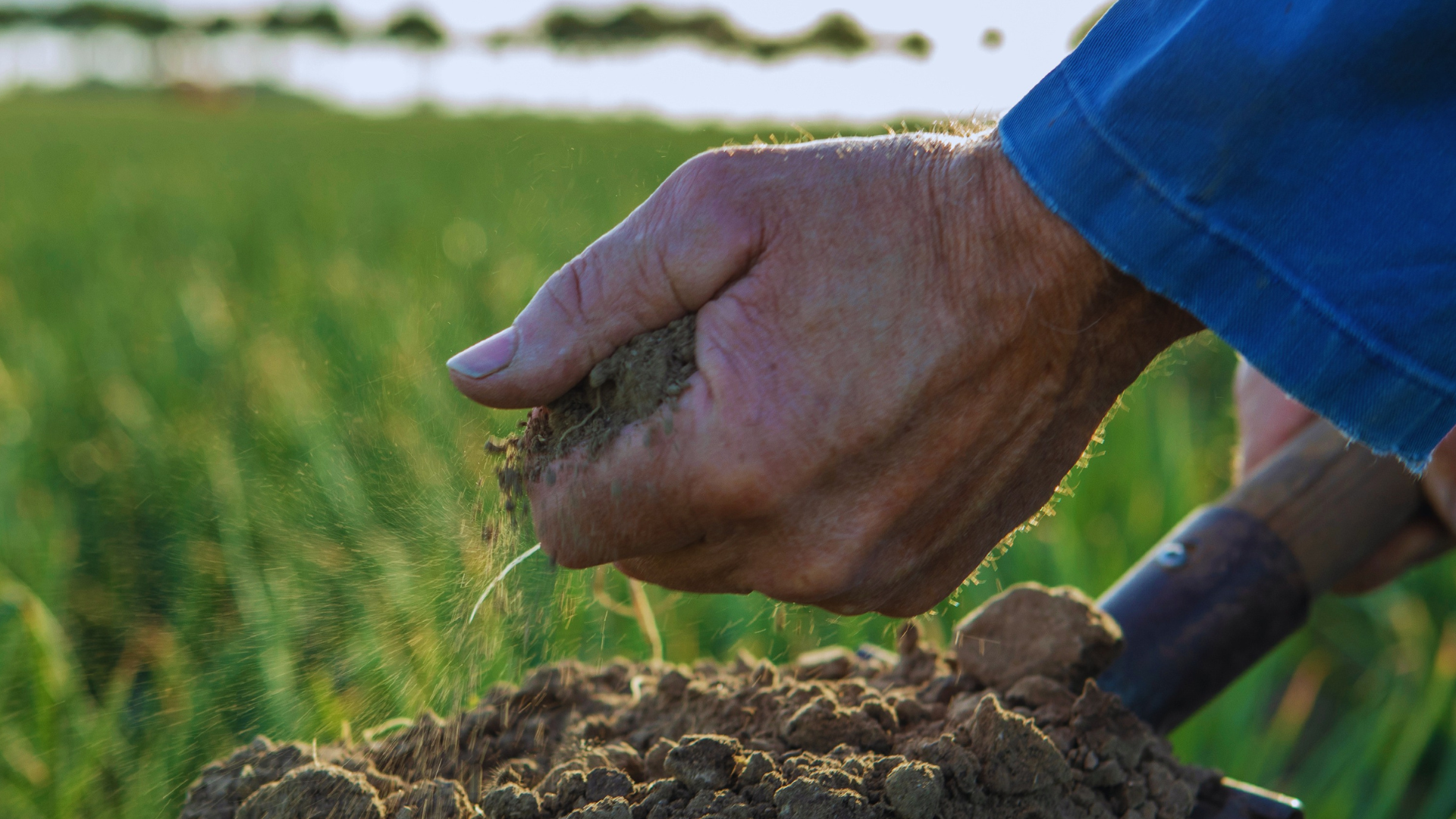
Disrupted growth
The growth of the onion crop can therefore be disrupted by cold or drought followed by rapid growth, also called growth explosion, which can lead to the so-called 'split butts', a phenomenon in which the onion basal plate and even the bulb itself splits. A second threat is hail damage. This gives internal discoloration of the skirts and increases the risk of infection and attack by fungi, bacteria or insects. After all, leaf damage is an open entry point for countless unwanted pathogens. And then there is always the threat of too much precipitation in the Netherlands. That causes a lack of oxygen with a compacting soil or -when large puddles of water remain- even yellowing of the foliage or death.
Green manures
Green manures have of course already done a lot of useful groundwork for the Dutch grower by adding organic matter. Organic matter is important for the supply of nitrogen, phosphate and other natural nutrients. They represent a good amount of biomass and thus have a favorable influence on the supply of nutrients and leaching. With the build-up of organic matter in the soil, it also becomes more attractive to soil organisms and fertilizers work better. Roughly two-thirds of the nutrient supply in the Netherlands consists of organic fertilizers and during the season the farmer adds the remaining part of specific mineral nutrients in the form of fertilizers with the greatest care and knowledge. Green manures absorb nutrients that have remained in the soil after the main crop has been grown and retain them for the benefit of the next crop. After the green manure has died, important nutrients such as potassium, manganese and phosphate become available for the onions.
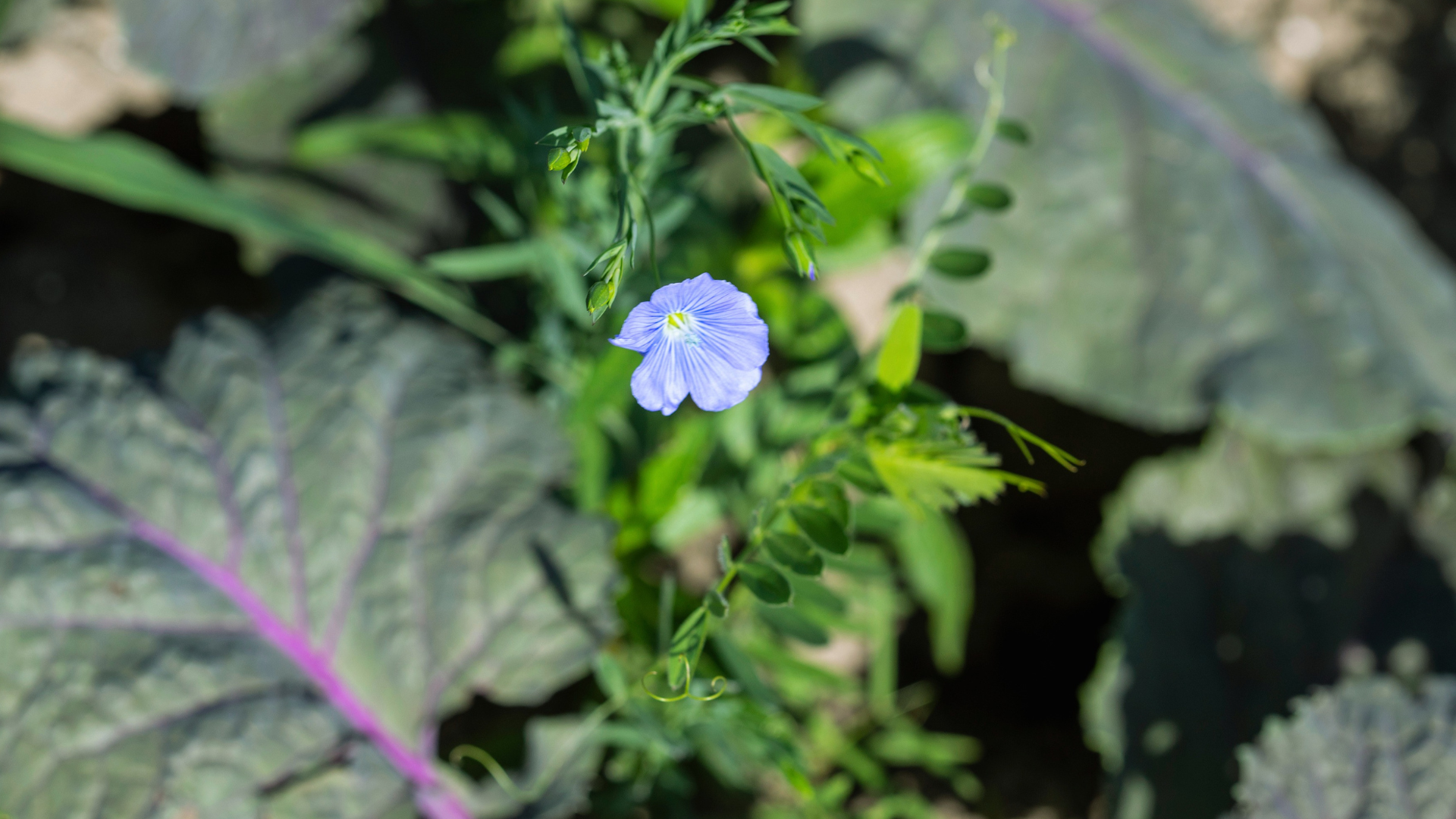
Thunder bugs
And when the crop has withstood all the natural elements, there are always those thunder bugs or thunderflies that, because of their massiveness, can seriously hit hard in a dry warm summer. Because thrips like warm conditions and hate moisture. Both the flies and the larvae cause small silvery spots in the longitudinal direction of the leaf. A real infestation can lead to a 40% loss of yield. Sterile insect technology is increasingly being used for successful control and control. But here too the rhythm of a daily observation in the field by the Dutch onion grower triumphs. Damages can be limited early on by doing a careful crop check every three days and looking in the axils of the leaves. Thrips are light shy and prefer to hide there at first.
And then the onion crop starts to bulb around the longest day with at least 16 hours of daylight. In this stage, the crop needs a lot of moisture to form the bulb. Without sufficient accessible water in the soil, the growth of the bulb stagnates. A moistured soil during the growing season makes or breaks successful onion cultivation.
